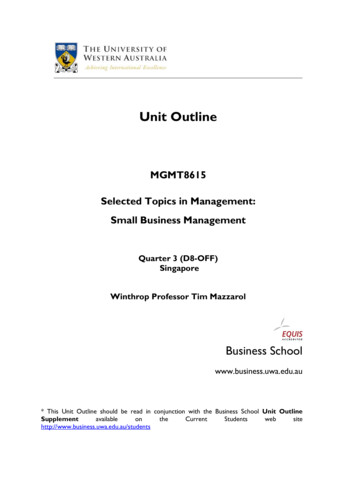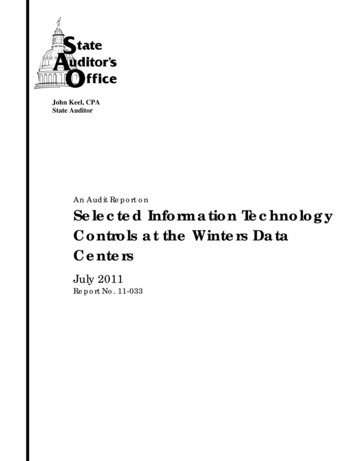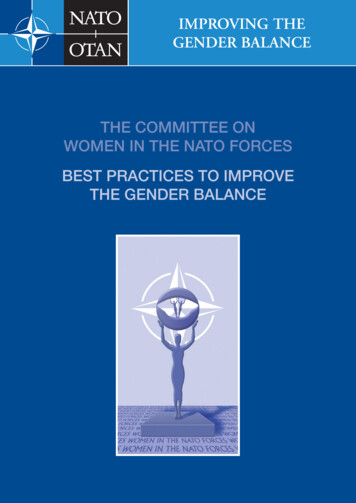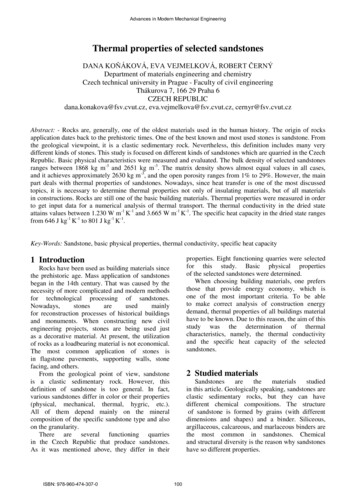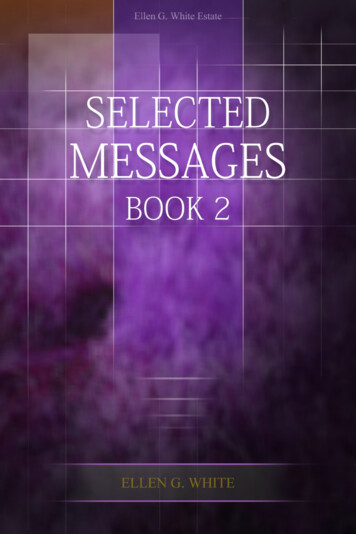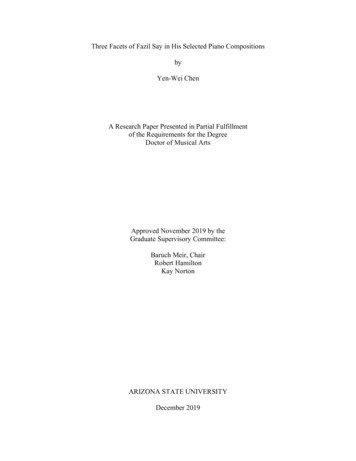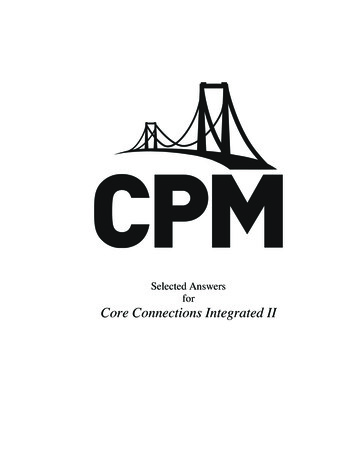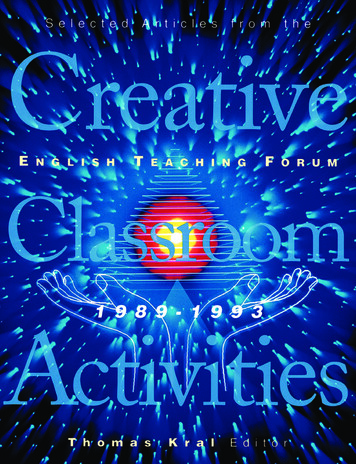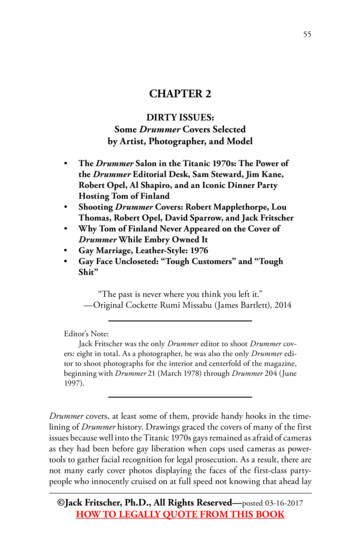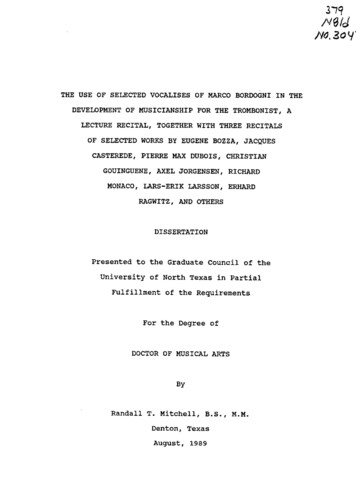
Transcription
319/V0/c/THE USE OF SELECTED VOCALISES OF MARCO BORDOGNI IN THEDEVELOPMENT OF MUSICIANSHIP FOR THE TROMBONIST, ALECTURE RECITAL, TOGETHER WITH THREE RECITALSOF SELECTED WORKS BY EUGENE BOZZA, JACQUESCASTEREDE, PIERRE MAX DUBOIS, CHRISTIANGOUINGUENE, AXEL JORGENSEN, RICHARDMONACO, LARS-ERIK LARSSON, ERHARDRAGWITZ, AND OTHERSDISSERTATIONPresented to the Graduate Council of theUniversity of North Texas in PartialFulfillment of the RequirementsFor the Degree ofDOCTOR OF MUSICAL ARTSByRandall T. Mitchell, B.S., M.M.Denton, TexasAugust, 1989
Mitchell, Randall T., The Use of Selected Vocalises ofMarco Bordoani in the Development of Musicianship for theTrombonist, a Lecture Recital. Together with Three SoloRecitals.Doctor of Musical Arts (Trombone Performance),August, 1989, 64 pp., 22 musical examples, bibliography, 55titles.This dissertation consists of three solo recitals andone lecture recital.The repertoire of all programs iscomposed of music written specifically for the trombone plustwo transcriptions of works for voice.The purpose of this paper is to investigate the use ofselected vocal pedagogical material as a means of developingmusicianship for the trombonist.The historicalrelationship of the voice and the trombone is traced throughwritten documentation and musical composition.Similaritiesbetween the development of legato technique for the vocalstudent and the trombonist are examined.A brief history ofthe vocalise and its pedagogical function is presented.development of expressive musical performance for thetrombonist is explored through the use of examples fromthree different vocalises of Marco Bordogni.The
Tape recordings of all performances submitted asdissertation requirements are on deposit in the Universityof North Texas Library.111
TABLE OF CONTENTSpagePERFORMANCE PROGRAMSFirst Solo RecitalviSecond Solo RecitalviiThird Solo RecitalviiiLecture RecitalLIST OF FIGURES.ix.XChapterI.INTRODUCTION.1II.HISTORICAL REFERENCES ATTRIBUTING VOCAL QUALITIESTO THE TROMBONE3Historical Documentation and GraphicRepresentationsHistorical Compositions Using theTrombone in a Vocal StyleIII.SIMILARITIES OF LEGATO STYLE FOR THE TROMBONE ANDTHE HUMAN VOICE15Vocal LegatoTrombone LegatoIV.V.VI.A BRIEF HISTORY OF THE VOCALISE22THE TROMBONE AND THE VOCALISE27THE TEACHING OF MUSICIANSHIP THROUGH THEVOCALISE30Flexibility and EndurancePhrasing and Breath ControlDynamics and ExpressionTempo and RubatoOrnamentationAlternate PositioningPhrase ShapingIV
VII.SUMMARY AND CONCLUSION57APPENDIX (Trombone Vocalise Editions)58BIBLIOGRAPHY61V
North Texas State UniversitySchool of MusicGraduate RecitalRANDY MITCHELL, TromboneAssisted by:Louise Lerch, PianoRonald Christoph, HornBrian Standridge, TrumpetMonday, April 23, 19848:00 p.m.Sonata for Trombone Solo and cital HallAnonymous(ca. 1665).Sigismond Stojowski(1869-1946)Suite for Trombone and Piano teRondeauIntermissionPierre Max Dubois(1930-)Concertino for Trombone (1957)PreludiumAria: Andante sostenutoFinale: Allegro giocosoLars-Erik Larsson(1908-)Sonata for Horn, Trumpetand Trombone (1922)Francis PoulencAllegro moderato(1899-1963)AndanteRondeauPresented i n p a r t i a l f u l f i l l m e n t of therequirements for the degree ofDoctor of Musical ArtsVI
NORTH TEXAS STATE UNIVERSITYSCHOOL OF MUSICG c33Graduate Recitala*siRANDY MITCHELL, Trombone\)Assisted byMark Hierholzer, PianoConcert Hall5:00 p.m.Monday, April 22, 1985Christian GouingueneConcerto(sur des themes d'Henicken)AllegroSicilienneAllegro vivoErhard Ragwitz(1933- )SonatineAllegro ma non troppoAdagioAllegro moltoAxel J rgensen(1881-1947)Suite, Op. 22I.II.III.TriomphaleMenuet giocosoBallade et PolonaiseIntermissionEugene Bozza(1905- )BalladeVariations on a March of ShostakovichArthur Frackenpohl(1924- )Presented in partial fulfillment of therequirments for the degree ofDoctor of Musical ArtsVII
iMMaaaiMKagmaiiiHayjipresentsGraduate RecitalRANDY MITCHELL, TromboneAssisted by:Hwa Jung Lee, PianoMonday, January 23, 19898:15 p.m.Concert HallCapriccio da camera, Opus 35 (1961),.Bernhard Krol(1920-)La Femme a Barbe (1957). .from "Tableaux Forains"Jose BerghmansSonata for Trombone and Piano (1969). . .AllegroAndanteAllegro moltoRichard A. Monaco(1930-1987)IntermissionSonatine for Trombone and Piano (1958). .Allegro vivoAndante sostenutoAllegroJacques Casterede(1926-)Sonatine-Impromptu (1985)Tendrement et balanceQuasi recitativoJoyeusementPierre Max Dubois(1930-)Presented in partial fulfillment of therequirements for the degree ofDoctor of Musical ArtsVill
presentsLecture RecitalRANDY MITCHELL, TromboneAssisted by:John Tarver, PianoSusan Masters, SopranoMonday June 26, 19896:15 p.m.Recital HallTHE USE OF SELECTED VOCALISES OF MARCO BORDOGNI IN THEDEVELOPMENT OF TECHNIQUE AND MUSICIANSHIPFOR THE TROMBONISTEtude No. 20. . .G. Marco Bordogni(1788-1856)Etude No. 76G. Marco BordogniConcerto for Trombone and PianoAndante cantabileN. Rimsky-Korsakov(1844-1908)Presented in partial fulfillment of therequirements for the degree ofDoctor of Musical ArtsIX
LIST OF FIGURESFigure1.2.3.PageFlexibility passage, Etude No. 20, measures 67, Bordogni-Sluchin35Flexibility passage, Etude No. 20, measures 2024, Bordogni-Sluchin36Flexibility passage, Etude No. 20, measures 89, Bordogni-Sluchin374.Finishing the phrase, Etude No. 20, measures 2730, Bordogni-Sluchin385.Catch breath, Etude No. 76, measures 13-14,Bordogni-Rochut.396.Pacing of the air, Etude No. 76, measures 25-26,Bordogni-Rochut407.Subtle dynamics, Etude No. 20, measures 6-7,Bordogni-Sluchin41Use of vibrato, Etude No. 76, measures 1-4,Bordogni-Rochut42Use of rubato, Etude No. 20, measures 2-3,Bordogni-Sluchin44Scale passages, Etude No. 76, measures 13-16,Bordogni-Rochut458.9.10.11.Grace notes, Etude No. 20, measures 35-36,Bordogni-Sluchin4612.Grace note development exercise13.The turn, Etude No. 76, measures 7-8, BordogniRochutThe turn, Etude No. 74, measure 26, BordogniRochut14.x. .4748
15.16.The turn, Etude No. 74, measure 7, BordogniRochut.49The trill, Etude No. 74, measures 1-5, BordogniRochut. . .5117.Trills in adjacent positions. .18.Inverted mordent substitution for trill, EtudeNo. 74, measures 1-5, Bordogni-Rochut52Alternate positions accelerate playing, Etude No.20, measures 21-24, Bordogni-Sluchin . . . . . .5319.5120.Alternate positions smooth out legato, Etude No.20, measures 2-3, Bordogni-Sluchin5421.Wide interval slur assist, Etude No. 20, measures33-34, Bordogni-Sluchin5522.Shaping the phrase, Etude No. 20, measures 2-5,Bordogni-SluchinXI56
CHAPTER IINTRODUCTIONAnalogies to the expressive quality of the voice areoften made in trombonist's applied lessons and masterclasses.This relationship is generally taken for grantedand has never been fully explained.Vocalists have had the distinct advantage of havingtext to serve as a guide for the expressive interpretationof their music.They display a sense of expression andrhythmic flexibility that many wind players seem to lack.The interpretation of music by wind players (andspecifically, by trombonists) becomes a more abstractproposition.notes.There usually is no text to interpret, onlyMany method books available to wind instrumentstudents stress technique and deal very little withexpression.The adaptation of vocal literature to developinstrumental musicianship becomes a timely and importantquestion.Vocal literature used as trombone pedagogicalmaterials can be traced to the mid-nineteenth century.Nevertheless, despite the long-standing importance of suchtranscriptions, to date only two studies have been writtenon the topic.A 1973 dissertation by Leroy Baxter at
2Arizona State University investigates the use of vocalpedagogical materials from the Classic and Romantic eras fortrombone.1A more recent study by Barbara Comelek, examinesvocal references concerning all wind instruments found inperformance practice treatises and handbooks.2Comelek'sstudy, however, does not deal with the actual use of vocalliterature as instructional material.Musicianship may mean many things to many people.Entire books have been written on this elusive subject.Forthe purposes of this paper, musicianship will encompassthose techniques that make expressive performance possible.I shall review the "vocal" history of the trombone,similarities of developing legato style in the voice and thetrombone, and specifically, the use of selected vocalises ofMarco Bordogni (1789-1856)3 as pedagogical materials todevelop musicianship for the trombonist.In the finalanalysis, the performer must do more than merely play thenotes—he must make music! eroy Everette Baxter, The Use of Selected VocalMaterials from the Classical and Romantic Periods as a Methodof Teaching Musical Stvle Characteristics to Trombone Students(Ed. D. dissertation, Arizona State University, 1975; AnnArbor, Mich.: University Microfilms, ADD 74-05456).2Barbara Comelek, Allusions to the Vocal Art in SelectedWind Instrument Pedagogical Sources (D.A. dissertation, BallState University, Muncie, IN, 1985;Ann Arbor, Mich.:University Microfilms, MBB 86-05937).3Marco Bordogni, an Italian operatic tenor, taught voiceat the Paris Conservatory from 1820 to 1856.
CHAPTER IIHISTORICAL REFERENCES ATTRIBUTING VOCALQUALITIES TO THE TROMBONEThe actual date of the origin of the trombone isshrouded in mystery.Contemporary scholarship has fixed thetime frame of origin to approximately the middle of thefifteenth century.4Since the inception of the sackbut, andlater the trombone, the instrument has enjoyed a closeassociation with the human voice and singing throughout itsuse in western music history.several forms:This association takesthe playing of pieces that originally werewritten for the voice; the doubling of voices in choirs; thereplacement or substitution of voices in choirs; and evenmusic written for the trombone in a vocal style.To document each instance of the "vocal" use of thetrombone is beyond the scope of this paper.The followingportion of this chapter will cite specific instances showinga comprehensive and progressive use of the trombone in aflowing, expressive, and lyrical style associated with vocalperformance, hereafter referred to as vocal style.AAnthony C. Baines, "Trombone," The New GroveDictionary of Music and Musicians. 20 vols., ed. StanleySadie (London: Macmillan, 1980), XIX, 166.
Historical Documentation andGraphic RepresentationsInformation available on the earliest use of thetrombone comes from the fifteenth century in a graphicrepresentation of the instrument in a performance context.A Florentine chest painting, "The Wedding of Adimari" (ca.1420),5 illustrates a sackbut player as part of a danceconsort which also includes three shawms.6An account ofthe wedding of the Duke of Burgundy in 1468 mentions a motetperformed by three shawms and a sackbut.7The early function of the trombone, as indicated inthese sources, was as a member of the alta musica. or thealta band.According to Johannes Tinctoris, this was anensemble composed of "loud" (haut) instruments.Included inthe "loud" category were instruments such as the trombone,bombarde, and shawm.8function:The alta band served an aristocraticthat of providing dance music for court dancesand incidental music at festive occasions.The source ofmusic performed by the alta band was originally the body of5Anthony C. Baines, "Trombone," Groves Dictionary ofMusic and Musicians. 5th ed., 10 vols., ed. Eric Blom (NewYork: St. Martin*s Press, 1954), VIII, 555.6Anthony C. Baines, Brass Instruments. Their Historyand Development (London: Faber and Faber, 1980), 107.7Ibid. 108. Willi Apel, "Alta," Harvard Dictionary of Music , 2nded. (Cambridge, Mass.: Harvard University Press, 1982), 30.
5vocal music that included the motet and the French chanson.9Later, the repertory included purely instrumental forms,such as dance suites, along with vocally derived pieces.Tinctoris, in his De inventione et usu musicae (ca. 1487),makes note of an alta band composed of shawms and atrombone.10The trombone, according to Baines, played thecontratenor part within the ensemble.11Toward the end of the fifteenth century, trombones werefirst used in the performance of church music, a functionthat was not surprising since the "warm, sombre tone" of thetrombone blended well with the voices.12Church and cityrecords from the late fifteenth century in Italy documentdetailed accounts of payment to trombonists for performingcivic and church services.13Several sixteenth-centurypaintings and woodcuts show trombones performing with churchchoirs.Of particular interest is a portion of HansBurgkmair's engravings "The Triumph of Maximilian" (ca.Egon Kenton, Life and Works of Giovanni Gabrieli. vol.16 of Musicoloqical Studies and Documentsr ed. ArmenCarapetyan (N.p.: American Institute of Musicology, 1967),468.10Baines, "Trombone," Groves Dictionary. VIII, 555.uBaines, Brass Instruments. 103.12ed.Philip Bate, The Trumpet and Trombone. 2nd revised(New York: W.W. Norton, 1978), 146.13Ibid.229.
61516).In one section, a wagon carrying a choir isaccompanied by a trombone and a cornetto."The first firm technical information concerning thetrombone appears in Michael Praetorius Svntacrma Musicum(1619).Virdung had illustrated a trombone earlier in hisMusica aetutscht of 1511, but he provided no otherinformation.Praetorius not only illustrates a woodcut of aconsort of trombones, but he also describes their size andkeys.Importantly, he labels the consort with vocaldesignations depending upon the individual playing register.Praetorius even makes note that he prefers the tone of thetenor trombone (rechteaemeine Posaun to that of the alto.15Marin Mersenne gives the first description of the toneand the use of the trombone. In his Harmonie Universella(1636), he states that the trombone should not be sounded inimitation of the trumpet.Instead, it should be sounded "sothat it imitat
Sonatine for Trombone and Piano (1958). . Allegro vivo Andante sostenuto Allegro Sonatine-Impromptu (1985) Tendrement et balance Quasi recitativo Joyeusement .Bernhard Krol (1920-) Jose Berghmans Richard A. Monaco (1930-1987) Jacques Casterede (1926-) Pierre Max Dubois (1930-) Presented in partial fulfillment of the requirements for the degree of .

